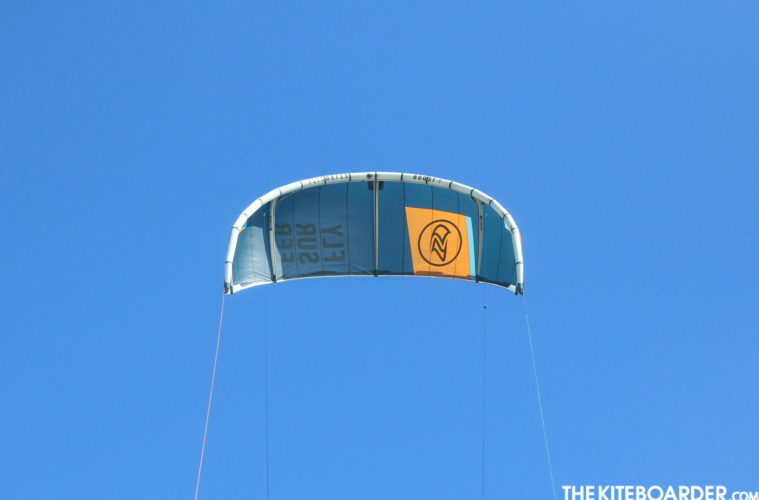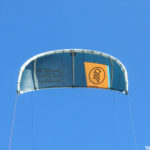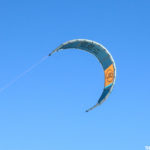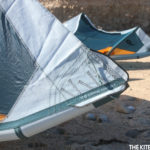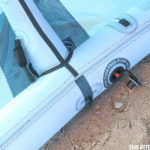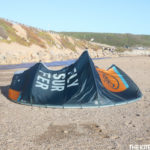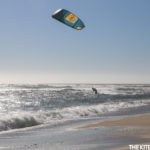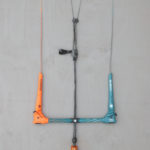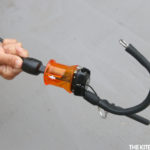Sizes Available: 7, 9, 11, 13, 15(LW), 18m(LW)
Sizes Tested: 9m, 11m
Flysurfer Says:
The BOOST is the first choice for simply having fun! Improve your riding, increase your jump height and count on the precise feedback at the bar. Uncomplicated, super simple and robust. Put the powerful freeride kite on the hook, it will always strengthen your confidence and you can grow beyond yourself!
Visit for more info: https://flysurfer.com/project/boost4/
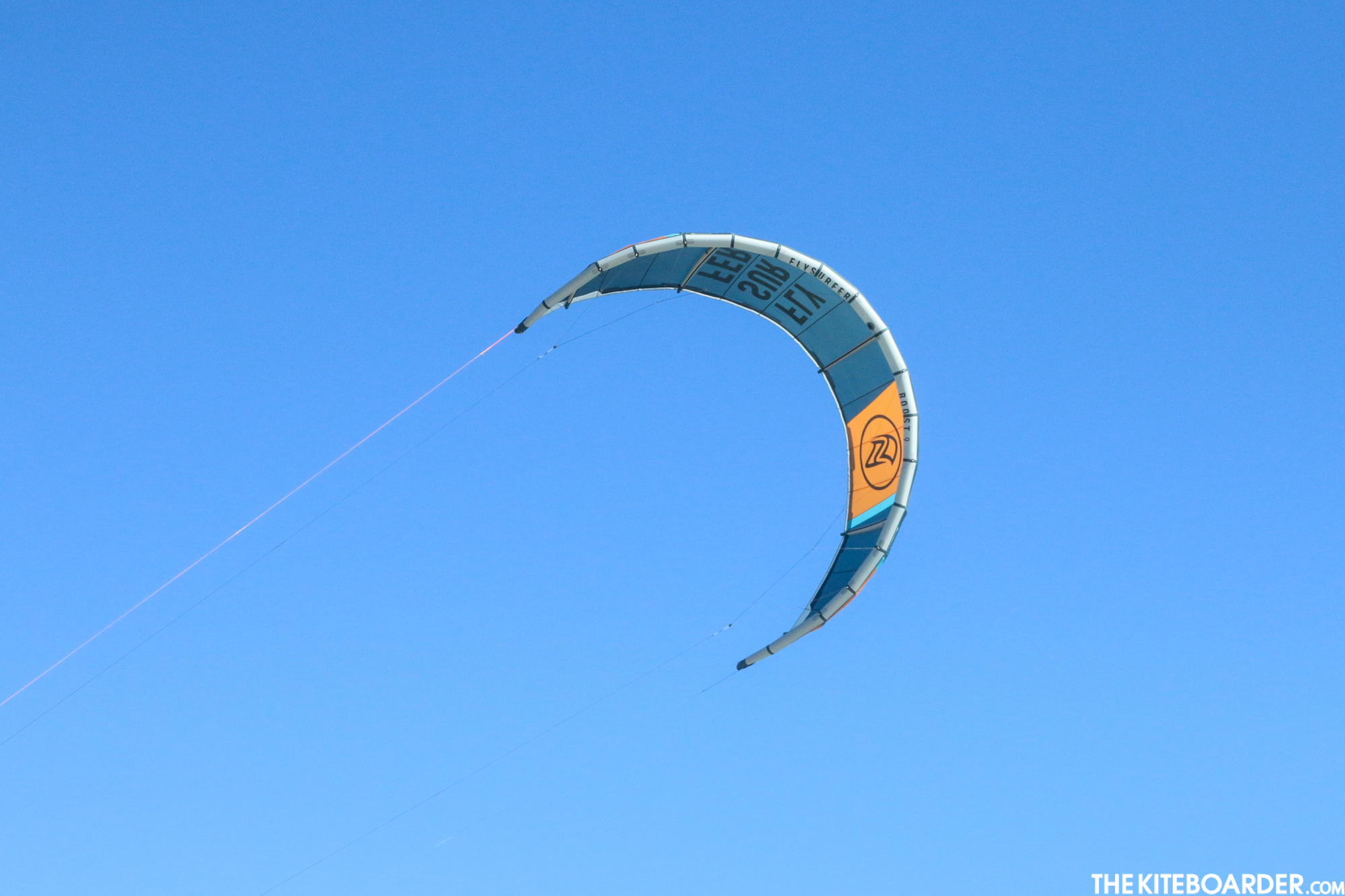
TKB Says:
The Boost is a 5-strut high aspect airframe that covers a lot of ground between course racing, big air freeride and twin tip light wind riding. As an IKA registered kite, the Boost can rock up to any LEI race and go for the podium, but it’s also a great big air jumping kite.
Inflation Valve: Push-button valve / special nozzle required
Flying Line Attachments: Bridle: Knot / Wingtip bridle: Knot
Centerline Split: Low-V
Front Bridle Options: Single setting / single Ronstan pulley
Design and Features
The Boost has the classic look of an inflatable race kite with its large high aspect canopy, sweptback leading edge and tons of flat pulling surface area in the center. The five-strut airframe is inflated with Flysurfer’s push-button inflation valve which keeps the pump hose attached to the valve while inflating and allows for deflation with the push of a button (just remember to push the button to close the valve (button sticking up) prior to inflating. While this valve is used by a number of companies, we’ve always liked how Flysurfer positions the valve so it is much easier to access while holding the kite in a rigging position. The Boost features a single setting front bridle which uses a single Ronstan pulley and an attachment point that ends in a knot. The front bridle is fairly short and doesn’t extend past the wingtip. It’s notable that Flysurfer’s front and back bridle attachment points both end in knots. The wingtip gives you three attachment points for tuning the steering force with the stock position in the middle. When the Boost is sitting on the beach, you’ll notice that the wingtips sweep back at a much higher angle, and the wingtip uses a fair amount of Dacron for strength with a trailing edge that mixes Dacron with double ripstop. The build quality is overall very solid to handle higher loads with tons of small quality details.
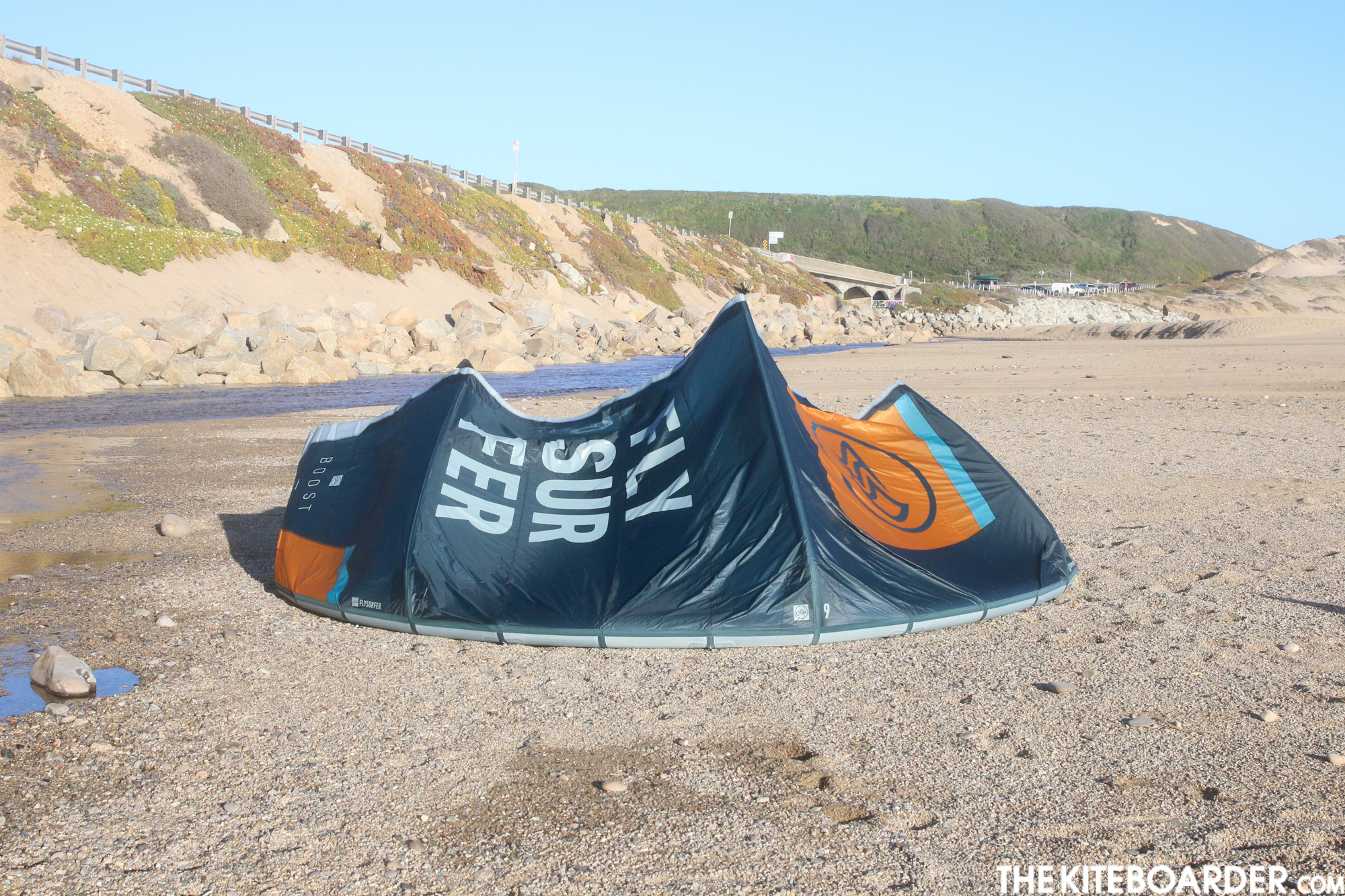
Impressions
One look at the Boost and you know you are dealing with a very different animal than most kiters are used to. The 5-strut airframe and large lifting canopy are designed to build a tremendous amount of forward flying power that either drives you across the finish line or send jumps into the stratosphere, but for those unique goals, you often make some handling sacrifices that make this kite more suitable for intermediate to advanced riders with specific performance demands. Straight off the beach, we noticed the medium-plus bar pressure that allows you to really connect with the pulling surface area at your disposal. The power delivery across the throw isn’t quite as progressive as some of the other Flysurfer kites. Instead, it feels like you get more power in the last few inches of sheeting completely in on the bar. On our first tack out, you can feel the Boost flying to the forward of the window, generating most of its power as it gains apparent wind. The Boost generates its power from moving it through the window, rather than the sheet and go power dynamics of a more freeride-oriented kite. When the Boost gets just a little bit of apparent wind you can feel its heavy pulling power equally in the center lines and control bar, giving you some grunt that accelerates quickly, along with a ton of power to direct into board speed or vertical lift. There is a good amount of depower at the end of the power stroke, but in big gusts, there’s a lot of canopy that still wants to pull you. While a higher aspect race plan is generally not known for its steering performance, the Boost did quite well with good steering initiation””the turning arc is a bit wider but still tight enough to keep its hand in the big air freeride game. The bar feel isn’t quite as intuitive for beginners, but more advanced kiters will find the Boost’s flying speed and access to an incredible amount of lift very useful for sending big jumps. We often noted second or even third pulses of lift on big lofty jumps, which tells you that the 5-strut high aspect airframe is wringing every inch of lift out of the wind. The Boost’s loft is solid with hangtime that seems to last and the steering is sufficiently quick and nimble to manage your flight and deliver soft landings. Since the Boost doesn’t have much wingtip surface area it does require a bit more bar pressure to keep it parked on the side of the window. The Boost seems to do a good job of balancing the drive you want in a race kite with the maneuverability you need to put all that lifting force to use in jumping. The balance between freight train pulling power and depower gives the Boost just enough user-friendly handling to keep it in the freeride category and makes it a candidate in the larger sizes for twin tip riders that want to push the lower reaches of the wind’s threshold. For those riders that take their airs seriously, the Boost delivers pulsey lift that converts every inch of power into vertical loft and then zooms back upwind to do it over again and again with a giant smile.
Featured Control Bar
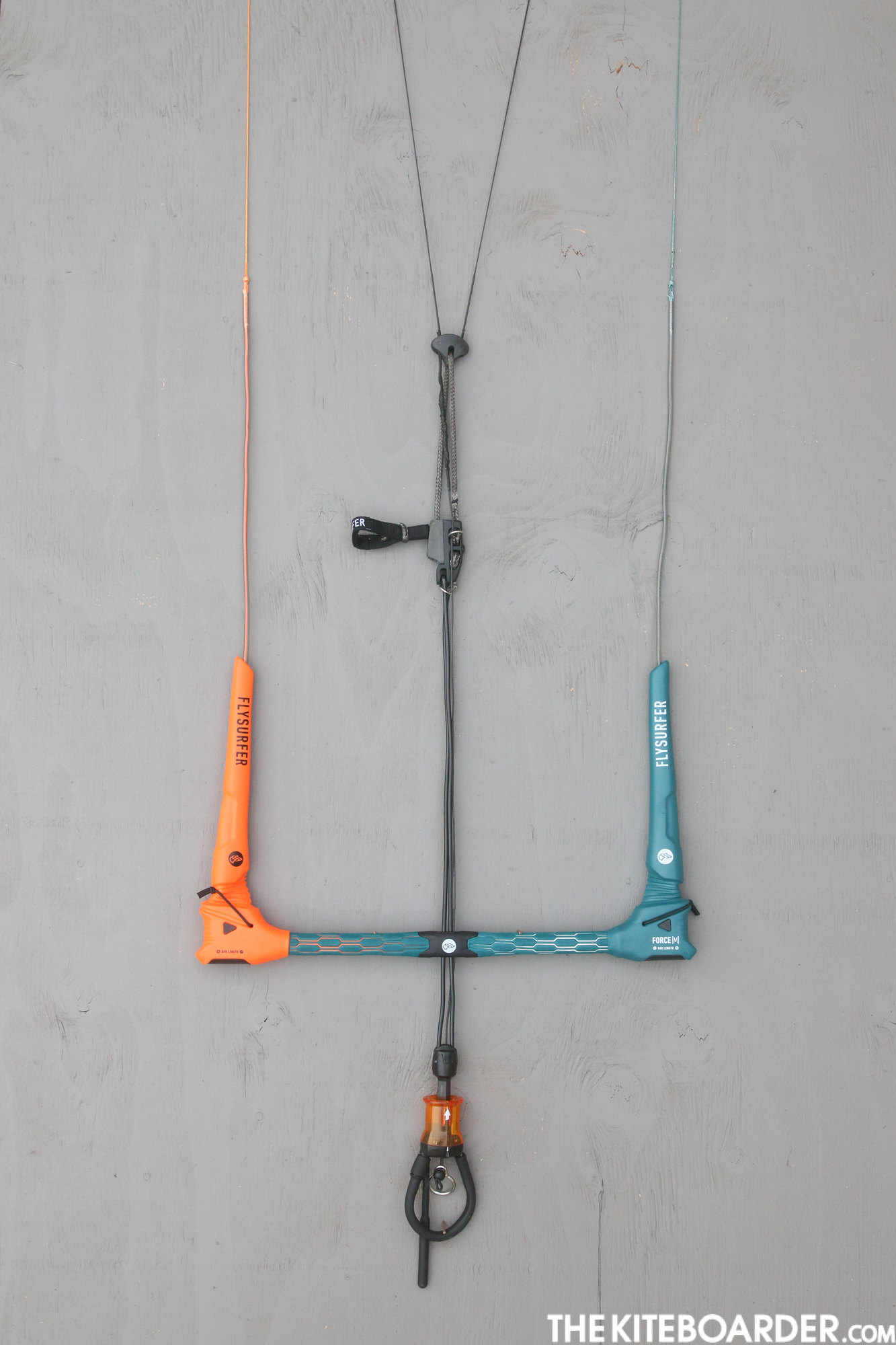 Flysurfer’s Force bar received a complete redesign last year and returns with a solid blend of function and comfort in a clean package. The Force comes in three different dual adjustment length sizes; small, medium and large (small 40-48cm, medium 47-55cm and large 55-63cm). The bar features single centerline depower with a double plastic-coated throw/power lines. The push away quick release features an above the bar swivel that also doubles as a quick-release guard, with the quick release being fairly easy to reassemble with two hands””just lift the gate, insert the loop, push down on a stainless tab with your thumb and let the gate slide back into place. The Force features a low V and a clam cleat power adjustment with a bungee built into the end of the power line so that the toggle stays relatively close. The bar features a nice EVA padded grip that offers a medium diameter grip that gets a little thicker towards the center. It has a plastic nylon replaceable center insert which features a smooth transition between the insert and the grip to avoid any discomfort. The grip has a rubbery feel with an indented pattern that is somewhat firm but good for attaining a good balance of grip. The bar ends have integrated foam floats and the option to adjust the effective bar length by pushing in the triangle buttons and pulling out a plastic tab on the bottom of the bar and swapping the insert’s orientation as well as choosing one of three knots to tune the length of your outside lines. It’s also got bungees that stow away but are easy to access and keep the lines nice and clean. The flying lines on the Force bar are crisp and thin which feel efficient through the air. Both outside steering lines and inside lines end in larks heads, so there’s no foolproof connection scheme. The Force’s control bar features add comfort, durability and safety for a top-of-the-line system that rings in at a nice light to medium weight that feels good in your hands.
Flysurfer’s Force bar received a complete redesign last year and returns with a solid blend of function and comfort in a clean package. The Force comes in three different dual adjustment length sizes; small, medium and large (small 40-48cm, medium 47-55cm and large 55-63cm). The bar features single centerline depower with a double plastic-coated throw/power lines. The push away quick release features an above the bar swivel that also doubles as a quick-release guard, with the quick release being fairly easy to reassemble with two hands””just lift the gate, insert the loop, push down on a stainless tab with your thumb and let the gate slide back into place. The Force features a low V and a clam cleat power adjustment with a bungee built into the end of the power line so that the toggle stays relatively close. The bar features a nice EVA padded grip that offers a medium diameter grip that gets a little thicker towards the center. It has a plastic nylon replaceable center insert which features a smooth transition between the insert and the grip to avoid any discomfort. The grip has a rubbery feel with an indented pattern that is somewhat firm but good for attaining a good balance of grip. The bar ends have integrated foam floats and the option to adjust the effective bar length by pushing in the triangle buttons and pulling out a plastic tab on the bottom of the bar and swapping the insert’s orientation as well as choosing one of three knots to tune the length of your outside lines. It’s also got bungees that stow away but are easy to access and keep the lines nice and clean. The flying lines on the Force bar are crisp and thin which feel efficient through the air. Both outside steering lines and inside lines end in larks heads, so there’s no foolproof connection scheme. The Force’s control bar features add comfort, durability and safety for a top-of-the-line system that rings in at a nice light to medium weight that feels good in your hands.
Visit for more info on the bar: www.flysurfer.com/project/force-control-bar/

With over 112 products reviewed, get the digital version of our 2021 Gear Review Guide that puts all the latest products reviews in one easy to access and searchable guide. Want a low-v bar with a durable PVC coated throw line and soft padded bar ends? Use our guide to stay on top of gear developments and find the exact piece of equipment to match your style.
*Already a subscriber or purchased our 2021 Gear Review Guide in the fall? Your guide has been updated to our latest version in your Tkb library. Log into your account to read the latest reviews.


